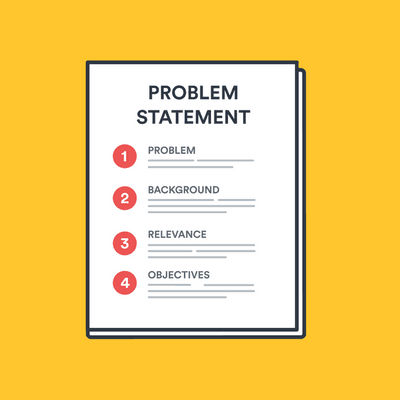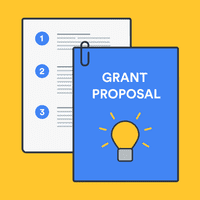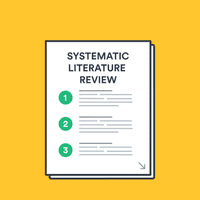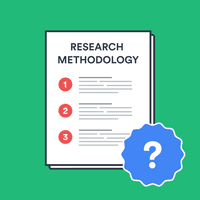How to write a problem statement

What is a problem statement?
A problem statement is a clear and concise description of the problem or issue a team aims to address in a project.
A problem statement identifies a problem’s current state, desired future state, and the gaps that lie between the two. It doesn't define the solution to the problem or provide a road map for solving the problem; it only gives an outline of what the problem is.
However, the researcher or team can later use the problem statement to validate that their work delivered an outcome that resulted in the solution.
Why write a problem statement?
A problem statement is a useful communication tool, as it keeps the whole team on track and tells them why the project is important. A problem statement helps someone to define and understand the problem, identify the goals of the project, and outline the scope of work.
A problem statement is especially relevant for projects that aim to improve processes, as it allows for the easier development of solutions. Referencing it helps guide the activities carried out and aids the research team in staying focused. The information in a problem statement also helps a team make important decisions.
When the desired solution is implemented later on, a problem statement can help make sure that steps are put into place to prevent the original problem from recurring in the future.
When are problem statements commonly written?
Problem statements are used in both academic and business contexts. In a business environment, project managers can use them to help execute process improvement projects.
But in an academic setting, they can help researchers to contextualize and understand the significance of the problem in a research project. This guide focuses on academic problem statements.
How do I write a problem statement?
Before planning or writing out your academic problem statement, ask yourself some important questions, and make notes with your answers:
- What is the problem?
- How often does the problem occur?
- Where does the problem occur?
- When does the problem occur?
- Who does the problem impact?
- What causes the problem?
- How would things ideally work if the problem wasn't present?
- Why is this a problem, and why does it matter?
- What impact does the problem cause?
- Which possible solution/s to the problem are you going to propose?
- What are the predicted benefits or outcomes of your solutions?
The format of a problem statement
When you write your problem statement, split it into four sections:
- Problem: Here, simply define what your problem is, clearly and concisely. Make it no longer than one or two sentences.
- Background: This is the section where you can describe what causes the problem, how often it occurs, where and when it occurs, and who the problem impacts.
- Relevance: You'll want to show how the problem is relevant, as well as why it matters and requires a solution. This is a great space to specify why it's a problem and what impacts it causes. If it fits comfortably, you can also articulate how things would ideally work if the problem wasn't present.
- Objectives: This section doesn't require great detail or length, as the problem statement isn't the area of your research project in which to specifically problem-solve. However, you should lay out a brief plan of what you're going to do to investigate and how that should help you formulate solutions. You can also hypothesize on possible solutions you're going to propose, and the benefits you predict from these.
The trademarks of a good problem statement
A quality problem statement should be:
- Concise: You should be able to summarize your problem, as well as the different elements of how and why it's a problem, in succinct sentences. If you can't, revisit your initial notes and clarify what you want to achieve with your project.
- Specific: Only write about one issue in a problem statement, even if there's more than one impact of that issue. Your research and actions then only have to focus on solving the one problem, and there's no confusion.
- Measurable: Be clear about how you're able to measure and convey both the problem and your proposed objectives. This is usually by communicating the problem in terms of degree and frequency.
An example of a problem statement
Below is an academic problem statement example. You don't need to include any headers in your real problem statement, but we'll do so here to show you how the sections of the document function in practice.
Problem
There is worryingly low uptake of free cervical cancer screening in the UK amongst women aged 25 to 35.
Background
According to an assessment conducted by X Health Trust, only 60% of 25- to 35-year-old female patients attended cervical cancer screening appointments within the last two years.
This could be due to several contributing factors:
- Female patients in this age group may be more likely to believe they are not susceptible to cervical cancer due to their younger age.
- There has been an absence of regular and informative public health announcements on this subject within the last seven years.
- Cervical cancer screening has a reputation for being an unpleasant experience, which could be off-putting for patients due to attend one.
Relevance
Cervical cancer is the 14th most common cancer in females in the UK, representing a notable health risk. As of 2017, there were around 3,200 new cervical cancer cases, with 850 consequent deaths, in the UK every year.
Although mortality rates in the UK for cervical cancer are highest in females aged 85 to 89, incidence rates for the disease are still highest in females aged 30 to 34.
When cervical cancer is diagnosed at its earliest stage, 96% of people diagnosed will survive their disease for one year or more. This is compared with only 50% of people when the disease is diagnosed at the latest stage.
Screening is a vital health service as many cervical cancer patients will be symptomless until they are in a later stage of the disease.
Objectives
We are going to conduct a survey of 10,000 females in the UK between the ages of 25 and 35. We will first ask them the question of whether they have attended a cervical screening appointment in the last five years. For those who answer “no,” we will then present them with multiple-choice options that answer the question, “why not?”
From the results we gather, we should be able to accurately assess the most common reasons why there is a low uptake in cervical cancer screening in this age group. We will then propose interventions to the medical community based on our findings.
Our ultimate goal is to increase the uptake of cervical cancer screening by females between 25 and 35 in the UK over the next five years.
🔲 Problem
🔲 Background
🔲 Relevance
🔲 Objectives
Frequently Asked Questions about problem statements
🕵🏽♂️ Why is a problem statement important in research?
A problem statement helps you define and understand a problem, identify the goals of your project, and outline the scope of your work. A problem statement is especially important for projects that aim to improve processes, as it allows for the easier development of solutions.
🤖 What makes a good problem statement?
A good problem statement is concise, specific and measurable. It summarizes the different elements of how and why it's a problem. It focusses on solving this one problem, and there is no confusion as to what the problem is and how it is solved. It is clear how the problem can be solved and how this can be measured.
👩⚕️ How do you start a problem statement?
To start a problem statement, first ask yourself some important questions to define the problem, like:
- What is the problem?
- What causes the problem?
- What impact does the problem cause?
- Why is this a problem, and why does it matter?
- Which possible solutions to the problem are you going to propose?
- What are the predicted benefits or outcomes of your solutions?
💪 What are the 4 elements of a problem statement?
When you write your problem statement, split it into these sections:
- Problem
- Background
- Relevance
- Objectives
👬🏽 How do you write a smart problem statement?
A smart problem statement is concise, specific and measurable. It should briefly describe the problem, where it is occurring, the timeframe over which it has been occurring, and the size and magnitude of the problem.


